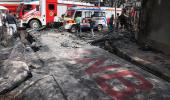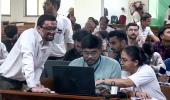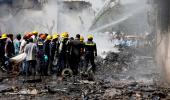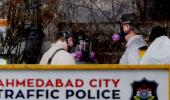'The AAIB will collect every single retrievable piece of the aircraft and transport it to a secure location -- usually a large hangar capable of housing a Boeing 787.'
'The entire aircraft will be laid out, each part marked and tagged, and practically rebuilt like a jigsaw puzzle'

In the second part of this interview with Prasanna D Zore/Rediff, aviation consultant and former Indian Air Force fighter pilot Captain Kishore Chinta, who now flies business jets and was part of India's early AAIB investigation panel, walks us through what happens once the Air Accidents Investigation Bureau (AAIB) arrives.
Drawing on his military precision and civil aviation experience, Captain Chinta describes how crash kits are deployed, flight data is recovered, and aircraft are painstakingly reassembled.
When the AAIB team arrives, how do they go about the investigation?
The AAIB team probably reached in the evening. They travel with their crash kit -- essentially a box containing gloves, masks, reflective vests, high-definition cameras, secure bags for evidence, and more. It's like a detective's kit -- used to gather, record, and preserve evidence at the scene.
They would have taken the first available flight and reached by evening (at the AI 171 crash site in Meghani Nagar, Ahmedabad).
Reports indicate that by evening, the first flight data recorder (FDR) had been found. On a Boeing 787, the CVR (cockpit voice recorder) and FDR are often integrated -- one may be located in the nose, the other in the tail.
Could you please explain that briefly?
In what people call the black box, it has something called an Enhanced Airborne Flight Recorder (EFR). This is a digital solid-state drive recorder.
It not only records voice like the traditional cockpit voice recorder, but also records flight data like a traditional flight data recorder.
To provide redundancy, there's one in the tail and one in the nose. This is a specific feature of the Boeing 787. The tail section EFR was recovered first.
What are the next steps for the AAIB as they progress?
What they will do next is based on ICAO Annex 13 (external link).
The ICAO (International Civil Aviation Organisation) has a list of annexures that all signatories to the International Civil Aviation Organisation have to comply with.
It's like an encyclopedia on which each civil aviation authority bases its own rules. You can be more stringent, but you must comply with the minimum ICAO requirements.
Annexure 13 covers air safety and accident/incident investigation. Further, there's document number 9756 (external link), the Manual of Air Accident Investigation.
It explains the entire process and guiding principles for air accident investigations.
This is what the AAIB would follow. The primary aim of any AAIB (in India we call it AAIB, in the US it's NTSB, in Canada it's TSB, in the UK it's AAIB) is to find out what happened, collect and analyse evidence, examine the circumstances leading to the accident, and then determine probable causes.
Finally, they make safety recommendations to prevent recurrence.
Nowhere in the AAIB's mandate is the apportioning of blame or punitive action. That's not its concern -- it's not their domain.
ICAO even mandates that names of the pilots are not to be included in the investigation report. Only their license numbers and experience levels will be noted, but names are withheld.
That document gives you an end-to-end view of how to go about it. It goes into great depth -- even down to determining whether something was burned in the air or after the crash. There are documented ways to find that out.
What happens to the wreckage?

The AAIB will collect every single retrievable piece of the aircraft and transport it to a secure location -- usually a large hangar capable of housing a Boeing 787.
The entire aircraft will be laid out, each part marked and tagged, and practically rebuilt like a jigsaw puzzle.
Whatever is left of the engines -- is that useful?
Absolutely. Some turbine and fan blades were intact, along with large parts of the engine casing. These will provide clues -- for example, whether the engines were rotating at impact. If the engines were rotating at high power, the damage is different than if they were stationary.
If the engines were rotating, would that indicate the engines had not failed?
Yes. Of course, the flight data recorder will tell whether the engines were producing thrust. Everything will be there, but it must be corroborated by physical evidence.
The FDR records every event, but if a warning came and went off quickly, it may not be recorded. Sometimes aviation systems generate spurious warnings that don't persist.
That's why every single data point from the FDR must be corroborated with physical evidence.
What kind of data does the EFR hold?
The process involves compiling and reassembling the aircraft, downloading and analysing the EFR (which is both the CVR and FDR), and reconstructing the entire flight -- from the time the aircraft's batteries were turned on at Ahmedabad after its earlier landing.
If the aircraft was on the ground for two hours, everything that happened will be in the FDR: Which panels were opened, how much fuel was uploaded, tire and brake temperatures, fuel temperatures -- even before the crew entered the cockpit.
If it was a crew change, the conversations between the old and new crew and with cabin crew will all be recorded via cockpit area microphones. Even casual comments or jokes will be on record.
This provides insight into whether pilots conducted briefings as per SOPs, followed checklists, and so on -- both through audio and the digital signatures in the FDR. Everything will be timestamped -- second by second, minute by minute.
There are software tools that can reconstruct the flight path from engine startup onward -- speed during taxi, engine power at takeoff, acceleration, distance covered -- everything.
What about viral videos -- do they help at all?
Those viral videos of the crash are just reference. They have no real consequence for the AAIB, which relies solely on hardcore data.
- Part III of the Interview: 'In Those 10 Seconds, Something Very Critical Happened'










